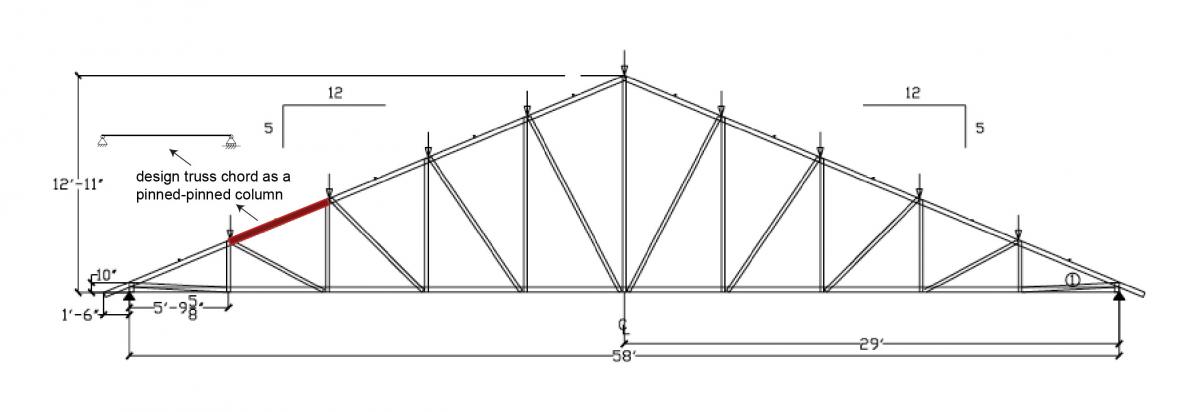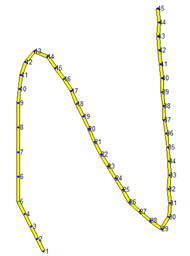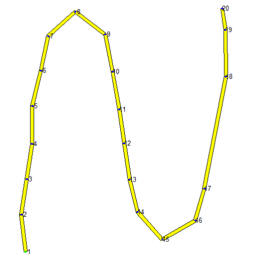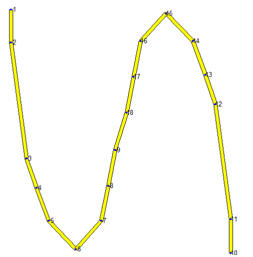CFS Competition 2012
2nd International Student Competition on Cold-Formed Steel Design
More Challenges Greater Awards
Official Website http://cfscompetition.unt.edu
Award Announcement
September 3, 2012
Results:
The 2nd Student Competition on Cold-Formed Steel Design has received a total of 56 entries from 4 institutions.
- University of North Texas, USA
- Virginia Tech, USA
- Chongqing University, China
- Texas Academy of Math and Science, USA
The judging panel carefully reviewed all entries and ranked them according to the design's efficiency and constructability as well as the quality of the essay.
The top 3 winners are the following.
|
Rank |
Name |
School |
Design |
Nominal compression strength |
|
1st |
Matthew Wilde |
Virginia Tech |
|
18.90 kips |
|
2nd |
Armen Adekristi |
Virginia Tech |
|
18.89 kips |
|
3rd |
Duping Zhang |
Chongqing University |
|
18.86 kips |
The other top 10 students are:
- Daniel Salinas, Virginia Tech
- Frank Smith, Virginia Tech
- Mandar Kulkarni, Virginia Tech
- Aaron Darlby, Virginia Tech
- Juloeta Ceballos, Virginia Tech
- Kyle Durham, University of North Texas
- Lauren Mcanallen, Virginia Tech
Awards:
The top 3 students will received individual cash award in amount of $700, $350, $200
respectively.
The top 3 students will receive individual award plaque by mail.
All top 10 students will received a one-year CFSEI student membership ( www.cfsei.org ).
We sincerely appreciate the supports and advices from the sponsors and many individuals. We look forward to holding the competition again in 2013. If you have any ideas, suggestions, or comments for this student competition, please send us emails at CFS_Competition@unt.edu or use the mailing address listed at the bottom of this page.
Original Announcement
March 11, 2012
Mission:
The mission of the International Student Competition on Cold-Formed Steel Design (CFS Design Student Competition) is to promote higher education in cold-formed steel structural design and to encourage students to use creative thinking skills to solve engineering problems.
After a successful 1st CFS Design Student Competition held in 2011, the 2nd Competition is hosted again at the University of North Teas with more challenges and greater awards. We encourage the participation of any students at any level in any major as long as you are creative, interested in designing things, and eager to learn new technologies.
Sponsors:
- National Science Foundation, www.nsf.gov
- American Iron and Steel Institute, www.steel.org
- Cold-Formed Steel Engineers Institute, www.cfsei.org
- University of North Texas, www.unt.edu
Eligibility:
The 2012 CFS Design Competition is open to all full-time students at any level. All student entrants are required to work on the problem individually, and no team solutions are accepted.
Competition Organizer:
Dr. Cheng Yu, Associate Professor, University of North Texas.
Judging Panel:
- Rick Haws, P.E., Technical Service Manager, Nuconsteel, A Nucor Company.
- Roger A. LaBoube, Ph.D., P.E., Distinguished Teaching Professor, Missouri University of Science and Technology.
- Cristopher Moen, Ph.D., P.E., Assistant Professor, Virginia Tech.
- Sutton Stephens, Ph.D., P.E., S.E., Kansas State University.
- Cheng Yu, Ph.D., Associate Professor, University of North Texas.
Schedule:
- March 12, 2012 Competition starts, the design problem is announced.
- June 30, 2012 Submission deadline. All submissions shall be received electrically before 6:00 pm at student entrant's local time.
- August 2012 Winners selected by the Judging Panel.
- September 2012 Winners announced.
- September 2012 Awards mailed to the winning students.
Awards:
- 1st place student will receive a $700 USD monetary award.
- 2nd place student will receive a $350 USD monetary award.
- 3rd place student will received a $200 USD monetary award.
- Each of the top 3 winning students will receive an Award Plaque.
- Each of the top 10 winning students will receive a one-year CFSEI student membership.
The winning designs will be recognized and exhibited at appropriate platforms such as professional conferences, websites and news letters.
The 2nd CFS Design Competition Problem:
Task
To design an open section shape for a 48-inch (1219-mm) long cold-formed steel truss
member which yields the highest possible nominal compression strength. Distortional
buckling is ignored.

Requirements
- The original steel sheet is 50 ksi (344.7 MPa), 10-inch (254-mm) wide, 0.0451-inch (1.1455-mm) thick, 48-inch (1219-mm) long.
- The section shall have a minimum 1.5-inch (38.1-mm) wide flange to accommodate screw-fastened sheathing attachments.
- The cross-section shall be an open shape.
- Sharp corners (zero radius) can be assumed.
- Pin-end boundary conditions.
- Cold-formed steel properties: elastic modulus E=29500 ksi (203.4 GPa), Possion's ratio v=0.3.
- Students shall submit the design individually, team work will not be accepted.
Tool
Use an open source software CUFSM to perform the elastic buckling analysis to determine the critical elastic buckling loads. CUFSM 3.12 can be downloaded here. More information about the software can be found in this link.
Use the Direct Strength Method to determine the nominal compression strength. The distortional buckling is ignored.
The Direct Strength Method provisions can be found in the Appendix 1 of the AISI S100-07 North American Specification for Cold-Formed Steel Structural Members. AISI permits the students to download the AISI S100-07 Appendix 1 for use in this competition only.
Design Package and Submission Info
The design package (zipped in one file) must be submitted via email to CFS_Competition@unt.edu by 6:00pm on June 30, 2012, at student' local time.
The design package shall include three documents:
- Completed the Information Form.
- A design essay (in Word or PDF).
- The CUFSM result file ( .mat file).
The design package (3 documents) shall be zipped to one single .zip or .rar file, and then emailed to the above address. The name of the single file shall be in the format: first name_last name.zip or first name_last name.rar.
Requirement for Design Essay
A brief essay (in English), limited to maximum 5 letter-size pages, is required as part of the design package. The essay shall describe the concept of the design, the methodology used for optimization, and the detailed calculation of the nominal compression strength.
Evaluation Criteria:
Only completed submissions will be evaluated. The designs with correct nominal strength calculations are eligible for awards. The primary consideration will be given to the effectiveness of the cross-section shape (the higher nominal compression strength the better). Only for designs with an equal compression strength, the one with better constructability will be ranked higher.
Tutorial and Design Example:
The competition is about creating optimal shapes under certain restrictions. Students with any background should be able to come up with a design and go through the analysis procedure to obtain the critical elastic buckling load in CUFSM.
What you really need to do is to define a cross-section shape and follow the procedure described in the example to determine the nominal compression load. Repeat the steps to figure out the optimal cross-section shape.
Q and A:
1. The CUFSM only takes two decimals for coordinate inputs but my design has many small elements which need at least four decimals for the node coordinates.
Solution: Use '1/100 inch' as the length unit so that you can adopt more decimals for the coordinates.
What is Cold-Formed Steel?
Cold-formed steel - Wikipedia. http://en.wikipedia.org/wiki/Cold_formed_steel
CCFSS Cold-Formed Steel for Students. http://www.ccfssonline.org/Student/Student.html
For More Information:
Additional questions on the competition subject, CUFSM software, and submissions should be addressed to:
Cheng Yu, Associate Professor
University of North Texas
3940 E. Elm St., Suite F115
Denton, TX 76207
Tel: 940.565.2022
Fax: 940.565.2666
e-mail: Cheng.Yu@unt.edu
Acknowledgment:
The Competition organizer would like to thank the Sponsors for their financial supports. The Competition is partially funded by the National Science Foundation through a CAREER award (NSF CMMI #0955189). The momentary awards for 2012 Competition are provided by the American Iron and Steel Institute. The one-year CFSEI student memberships for the top 10 students are provided by the Cold-Formed Steel Engineers Institute. Any opinions, findings, and conclusions or recommendations expressed in this Competition do not necessarily reflect the views of the National Science Foundation.
The 2012 competition problem was designed by the Judging Panel, their technical advises to this event is greatly appreciated. Special thanks go to Dr. Ben Schafer at the Johns Hopkins University who provided the CUFSM software for this event.
The Competition could not be successful without the promotion and support by the following organizations:
- American Iron and Steel Institute, Education Committee,
- American Society of Civil Engineers, Cold-Formed Member Committee,
- Structural Stability Research Council, Thin-Walled Structures Task Group.


